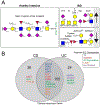Intestinal epithelial glycosylation in homeostasis and gut microbiota interactions in IBD
- PMID: 32710014
- PMCID: PMC8211394
- DOI: 10.1038/s41575-020-0331-7
Intestinal epithelial glycosylation in homeostasis and gut microbiota interactions in IBD
Abstract
Inflammatory bowel disease (IBD) affects 6.8 million people globally. A variety of factors have been implicated in IBD pathogenesis, including host genetics, immune dysregulation and gut microbiota alterations. Emerging evidence implicates intestinal epithelial glycosylation as an underappreciated process that interfaces with these three factors. IBD is associated with increased expression of truncated O-glycans as well as altered expression of terminal glycan structures. IBD genes, glycosyltransferase mislocalization, altered glycosyltransferase and glycosidase expression and dysbiosis drive changes in the glycome. These glycan changes disrupt the mucus layer, glycan-lectin interactions, host-microorganism interactions and mucosal immunity, and ultimately contribute to IBD pathogenesis. Epithelial glycans are especially critical in regulating the gut microbiota through providing bacterial ligands and nutrients and ultimately determining the spatial organization of the gut microbiota. In this Review, we discuss the regulation of intestinal epithelial glycosylation, altered epithelial glycosylation in IBD and mechanisms for how these alterations contribute to disease pathobiology. We hope that this Review provides a foundation for future studies on IBD glycosylation and the emergence of glycan-inspired therapies for IBD.
Conflict of interest statement
Competing interests
The authors declare no competing interests.
Figures






References
-
- Loftus EV Jr. Clinical epidemiology of inflammatory bowel disease: Incidence, prevalence, and environmental influences. Gastroenterology 126, 1504–1517 (2004). - PubMed
-
- Kumar V, Abbas AK & Aster JC Robbins and Cotran pathologic basis of disease. Ninth edition. edn, (Elsevier/Saunders, 2015).
-
- Collaborators, G. B. D. I. B. D. The global, regional, and national burden of inflammatory bowel disease in 195 countries and territories, 1990–2017: a systematic analysis for the Global Burden of Disease Study 2017. Lancet Gastroenterol Hepatol 5, 17–30, doi:10.1016/S2468-1253(19)30333-4 (2020). - DOI - PMC - PubMed
Publication types
MeSH terms
Substances
Grants and funding
LinkOut - more resources
Full Text Sources

